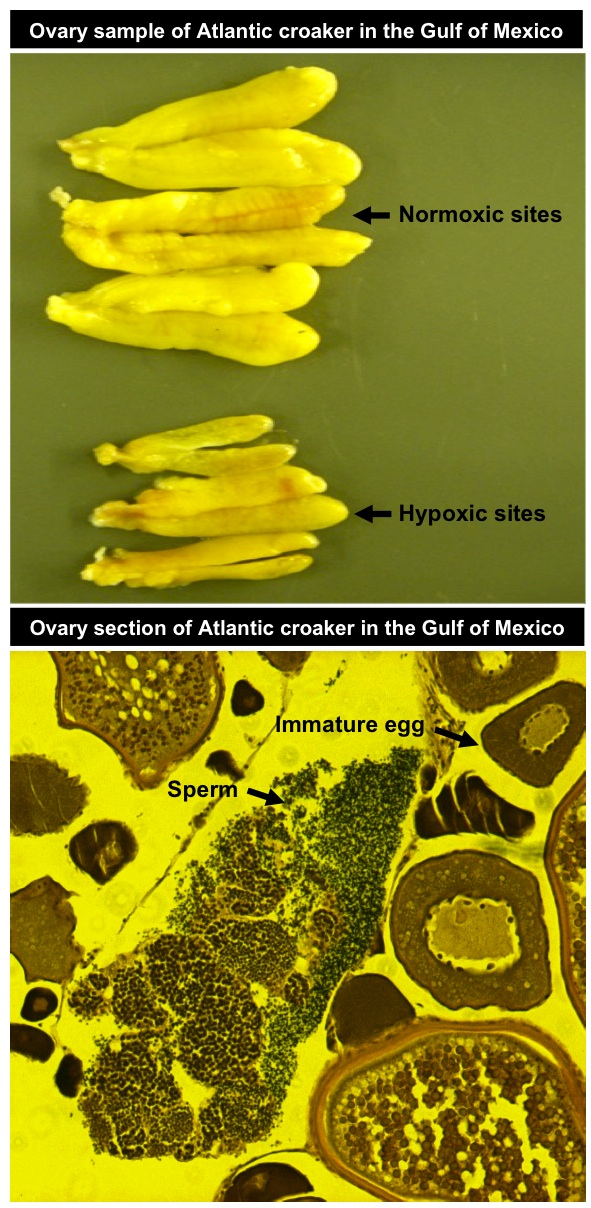Low Oxygen in Gulf of Mexico Has Fish Sexually Confused

You might get a little woozy without enough oxygen, but Atlantic croakers react to low oxygen levels in a completely different way: Their reproductive organs get confused.
In such a hypoxic environment, female fish started producing sperm in their ovaries, the researchers found.
"Hypoxia has increased dramatically over the last 25 years around the world," said study researcher Peter Thomas, of the University of Texas at Austin. "This is the first study to show an important biological effect of hypoxia on mobile organisms, like fish, that could have a long-term population impact." [Album: Stunning He-She Males of the Animal World]
Dead zones — areas where oxygen is too low to sustain much life — occur throughout the world's oceans, but they are much more prevalent in the Northern Hemisphere. There, high population levels along coasts lead to more pollution in the waters and therefore more algal growth, which sucks up any available oxygen.
Declining fish populations could have a tremendous impact not only on the water's ecosystem but on local fisheries and the economies that go with them.
Oxygen-starved
The Dead Zone in the Gulf of Mexico is caused by agricultural runoff of fertilizers, like nitrogen, from the Southern states. This runoff spurs the growth of oxygen-sapping algae, leaving less oxygen for the rest of the animals. The 8,543-square-mile patch (22,126 square kilometers) of low-oxygen water is equivalent in size to the state of New Jersey.
Get the world’s most fascinating discoveries delivered straight to your inbox.
Researchers studied fish caught over several years in this low-oxygen area to see how the fish were affected by their environment.
Thomas and his colleagues found severely impaired reproductive systems in many of the fish. The males had low sperm counts and low sperm mobility, while the females had below-average numbers of eggs that didn't mature correctly. The researchers also noticed there were more males than females.
The most surprising find, Thomas said, was that about 20 percent of the females had sperm in their ovaries. The low-oxygen environment had disrupted their sexual development, confusing their reproductive organs into making male sex cells instead of female. They saw the same results in Atlantic croakers they raised in the lab under low-oxygen conditions.
Sexually confused
The sexual dysfunction might be an energy-saving strategy, the researchers say. The fish, needing more energy to go about living and feeding, respond to the low-oxygen conditions by shutting down their reproductive systems. This is no problem for a year, but when the dead zone returns year after year, it can lead to serious population drops over time.
"The importance is not just for fish in the Gulf of Mexico, but fish in other regions," Thomas told LiveScience. "It could have a huge impact on fishermen and the economy, as well as the ecological impact. ... You could wind up with local extinctions of species."
Thomas and his colleagues are continuing to monitor the fish in the Gulf and other dead zones. They are also building predictive models based on what they've found, to determine what will happen to the population over time if these conditions continue.
Follow LiveScience for the latest in science news and discoveries on Twitter @livescience and on Facebook.
Jennifer Welsh is a Connecticut-based science writer and editor and a regular contributor to Live Science. She also has several years of bench work in cancer research and anti-viral drug discovery under her belt. She has previously written for Science News, VerywellHealth, The Scientist, Discover Magazine, WIRED Science, and Business Insider.




